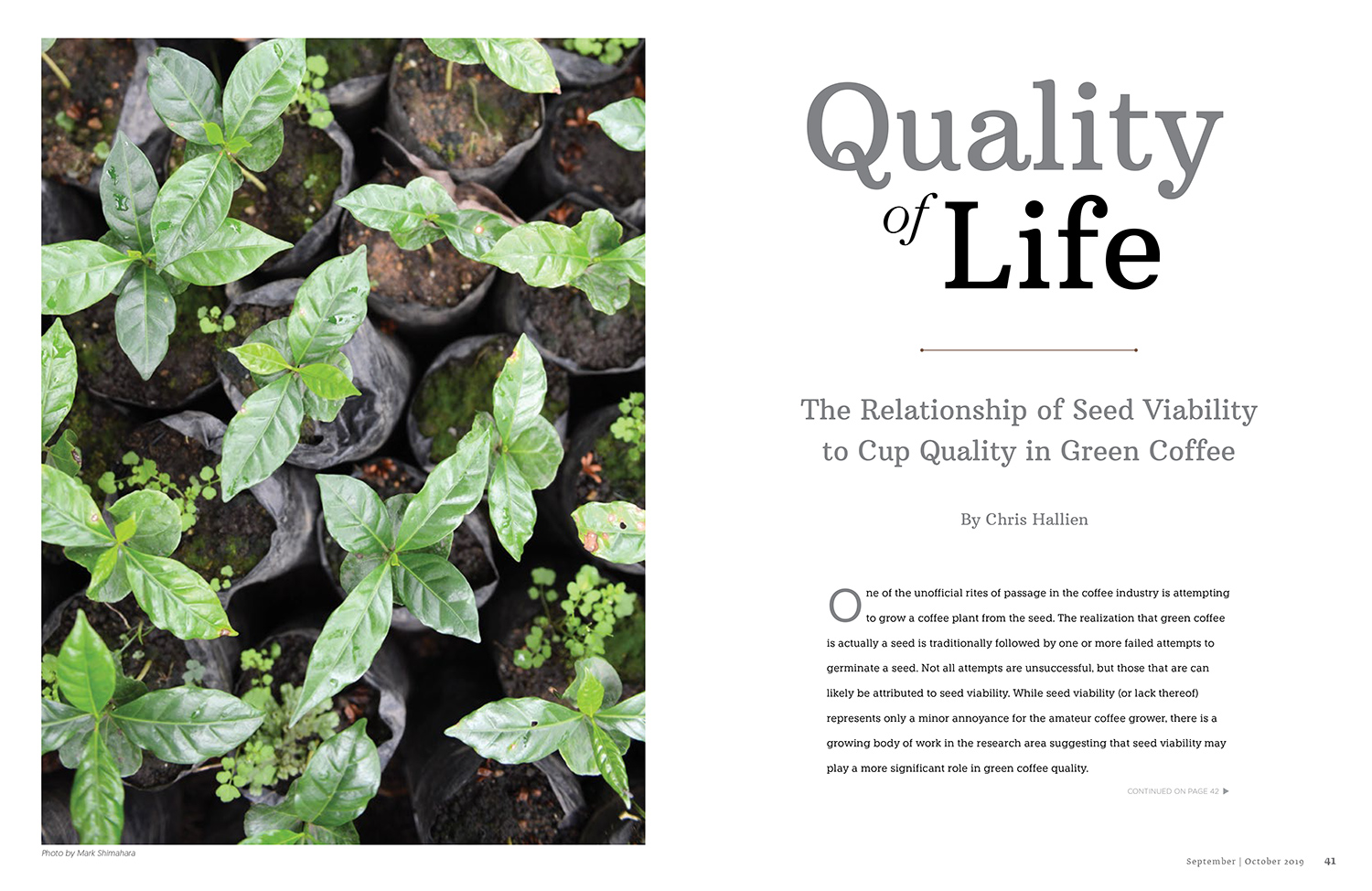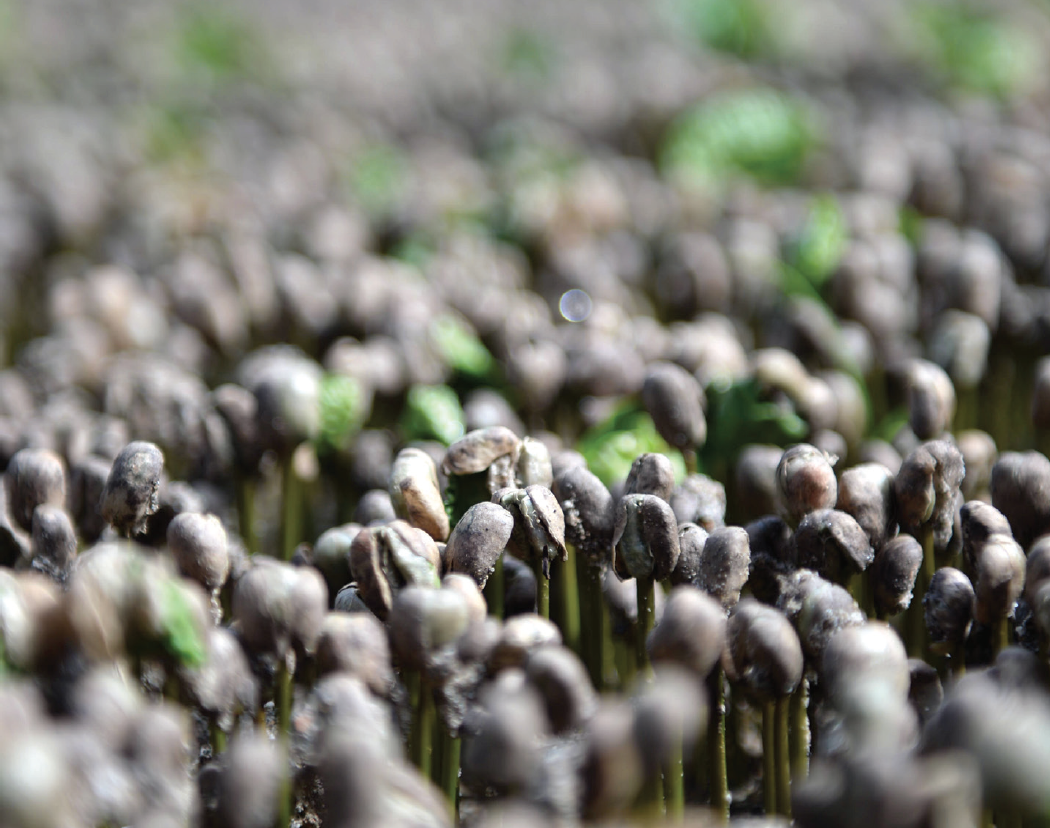(Editor’s note: The following comes from an article by Chris Hallien that appeared in the September/October 2019 issue of Roast Magazine. Click here to read the full article.)
One of the unofficial rites of passage in the coffee industry is attempting to grow a coffee plant from the seed. The realization that green coffee is actually a seed is traditionally followed by one or more failed attempts to germinate a seed. Not all attempts are unsuccessful, but those that are can likely be attributed to seed viability. While seed viability (or lack thereof) represents only a minor annoyance for the amateur coffee grower, there is a growing body of work in the research area suggesting that seed viability may play a more significant role in green coffee quality.
Several research papers have been published over the years demonstrating a direct correlation between seed viability and cup quality scores in green coffee; the higher the seed viability, the higher the quality. The specific focus of research in the various efforts may differ, but common to all research is leveraging of test methods used by the broader seed industry to apply to green coffee in order to assess cup quality. The body of work provides a compelling case for applying quality measurements of the seed industry to further advance the understanding of green coffee quality.
Seed Basics and Classifications
From a scientific perspective, seeds are a function of the reproductive cycle of a plant. The flower of a plant, once pollinated, will develop one or more seeds. The seeds themselves are plants in an early “embryonic” stage of development, capable of developing into an adult plant. A typical seed consists of three parts: 1) an embryo, the portion of the seed containing the precursory tissue for the stem, roots and leaves 2) an endosperm, the portion of the seed containing nutrients for the embryo and 3) an endocarp, the seed covering. A typical coffee seed is approximately 5 percent embryo and 95 percent endosperm (a proportion that will be revisited later); the endocarp is the “parchment.”
Seeds can be classified from a variety of perspectives. For the purpose of this subject, the classification of interest pertains to the physiological behavior of a seed when undergoing a desiccation (drying) phase and subjected to freezing temperatures:
- Orthodox seeds can be dried to as low as 5 percent moisture content and tolerate freezing. The longevity of orthodox seeds ranges from one year to several hundred years, depending on the type of plant and the storage conditions. Examples of orthodox seeds include most grain and legumes, as well as crop plants such as corn and tomato.
- Recalcitrant seeds (unorthodox seeds) cannot be dried below 20 to 30 percent moisture content and cannot tolerate freezing. The longevity of recalcitrant seeds ranges from days to less than one year. Examples of recalcitrant seeds include cocoa, avocado, coconut and mango.
- Intermediate seeds do not fully conform to the definition of either orthodox or recalcitrant. In some cases, intermediate seeds may have drying capabilities lower than 20 percent moisture content but are not tolerant of freezing.
Coffee is classified as an intermediate seed due to its ability to be maintained for several months at 10 to 12 percent moisture content, despite not being tolerant of extreme drying and/or freezing temperatures.
Both the drying phase and exposure to extreme temperatures represent sources of stress to a seed. The above classifications relate to the seed’s ability to maintain viability when subjected to such stress. Viable seeds are those that are capable of germination when provided with suitable conditions, meaning that the embryo of the seed has maintained its capacity to grow after a period of dormancy. These traits are critical to the survival of plants in their natural settings, especially in seasonal environments; seeds deposited in one season may remain dormant for months or years, in unfavorable conditions, but can become metabolically active upon exposure to favorable conditions.
[Click here to read the full article]
______
Chris Hallien is product manager for Cropster: Roast and Cropster: Coffee Lab. He is a longstanding member of and presenter for the Coffee Roasters Guild (CRG) and the Specialty Coffee Association (SCA). He serves on the Standards Committee for the SCA and the CRG Advisory Council. Hallien is a licensed C-grader, licensed Q-grader, certified sensory scientist and food scientist.








Comment